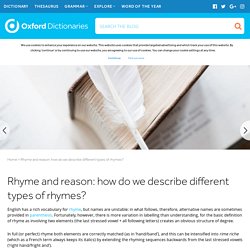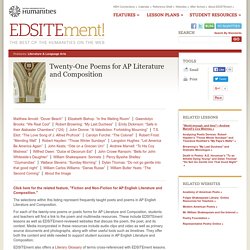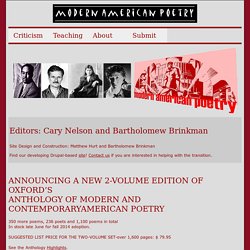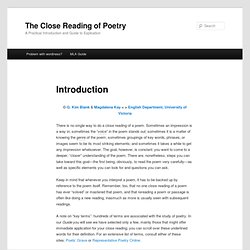

Roger Robinson. Revising unseen poetry » Slow Teaching. 03 Mar 2017 “Hope is being able to see there is light despite all of the darkness” Desmond Tutu.

This gentleman beautifully encapsulates Year 11’s approach to unseen poetry at this stage of the term: utterly lacking in direction and blindly searching for something, anything to hold on to. I fully empathise with them: how often can we immediately grasp the nuances of poetry on a first reading, let alone make comparisons with another unseen poem straight afterwards? Particularly given in their WJEC Eduqas examination, it will be the last hour of a two hour and thirty minute exam! Having spent some time this week reading T.S Eliot’s poetry I can completely understand that feeling of blind panic, intellectual inferiority and confusion that poetry can engender.
This week I decided to use two poems to build up a repertoire of skills with Year 11: Brian Bilson’s excellent ‘Refugee’ compared with Langston Hughes’ ‘I Too’. Word challenge: can you use me today? In my view the poem argues that… C.
Rhyme and reason: how do we describe different types of rhymes? English has a rich vocabulary for rhyme, but names are unstable: in what follows, therefore, alternative names are sometimes provided in parenthesis.

Fortunately, however, there is more variation in labelling than understanding, for the basic definition of rhyme as involving two elements (the last stressed vowel + all following letters) creates an obvious structure of degree. In full (or perfect) rhyme both elements are correctly matched (as in ‘hand/band’), and this can be intensified into rime riche (which as a French term always keeps its italics) by extending the rhyming sequences backwards from the last stressed vowels (‘right hánd/fright ánd’).
The obvious next step is half- (or imperfect, near, slant) rhyme, with only one element correctly matching, which divides into vowel rhyme, with the same last stressed vowel but different following letters (‘hand/hang’), and pararhyme, with the same letters following different vowels (‘hand/bind’). A second common analysis is by type. Twenty-One Poems for AP Literature and Composition. Click here for the related feature, "Fiction and Non-Fiction for AP English Literature and Composition.

" The selections within this listing represent frequently taught poets and poems in AP English Literature and Composition. For each of the twenty-one poems or poetic forms for AP Literature and Composition, students and teachers will find a link to the poem and multimedia resources. These include EDSITEment lessons as well as EDSITEment-reviewed websites that discuss the poem, the poet, and its context. Media incorporated in these resources include audio clips and video as well as primary source documents and photographs, along with other useful tools such as timelines. They offer both the content and skills needed to support student success in AP English Literature and Composition. EDSITEment also offers a Literary Glossary of terms cross-referenced with EDSITEment lessons. The largest mobile/online teen poetry community.
Poetry up close.
WH Auden. Chaucer. iGCSE Literature: Unseen Poetry by craig ennew on Prezi. Curvelearn.com: Poetry Analysis. Poetry Pairings. Resources : Learning Lab : Core Learning Poems. A poem for every day. MAPS. In stock late June for fall 2014 adoption.

The Modern American Poetry Site is a comprehensive learning environment and scholarly forum for the study of modern and contemporary American poetry. Started as a multimedia companion to the Anthology of Modern American Poetry (Oxford University Press, 2000), MAPS has grown over the past decade to more than 30,000 pages of biographies, critical essays, syllabi and images relating to 161 poets. Criticism can be viewed through the classic list of poets and through the new poet search page, where poets can be searched alphabetically, chronologically by birth date, by race/ethnicity, and by group/school of poetry. MAPS welcomes submissions of original essays and teaching materials related to MAPS poets and the Anthology of Modern American Poetry.
We are also happy to take questions and suggestions for future materials. Faculty of English: Classroom. Prosody Anecdotes. The Close Reading of Poetry. © G.

Kim Blank & Magdalena Kay < > English Department, University of Victoria There is no single way to do a close reading of a poem. Sometimes an impression is a way in; sometimes the “voice” in the poem stands out; sometimes it is a matter of knowing the genre of the poem; sometimes groupings of key words, phrases, or images seem to be its most striking elements; and sometimes it takes a while to get any impression whatsoever.
The goal, however, is constant: you want to come to a deeper, “closer” understanding of the poem. Death of a Naturalist - Poetry Analysis » Connecting with Seamus Heaney's Poetry. Kalaidjian/Roof/Watt, Understanding Literature, 1/e - Poetry. Materials for teachers. The Poets. The Poets There are 161 poet companion sites below.

The poems analyzed are available in Anthology of Modern American Poetry (Oxford) a Ai Sherman Alexie Angel Island Poetry A. John Ashbery back to top b Jimmy Santiago Baca Amiri Baraka John Beecher Gwendolyn Bennett John Berryman Elizabeth Bishop Paul Blackburn Robert Bly Louise Bogan Arna Bontemps Kay Boyle William Bronk Gwendolyn Brooks Sterling A. C Gladys May Casley-Hayford (Aquah LaLuah) Ana Castillo Marilyn Chin Sandra Cisneros Lucille Clifton Gregory Corso Jayne Cortez Hart Crane Robert Creeley Harry Crosby Countee Cullen E. D Joy Davidman James Dickey Emily Dickinson Hilda Doolittle (H.D.) Mark Doty Rita Dove Henry Dumas Paul Laurence Dunbar Alice Dunbar-Nelson Robert Duncan e T. Anita Endrezze Louise Erdrich Martìn Espada William Everson f Kenneth Fearing Carolyn Forché Sesshu Foster Charles Henri Ford Joseph Freeman Robert Frost Sol Funaroff g Allen Ginsberg Louise Glück Judy Grahn Angelina Weld Grimké h Michael S.
The Wondering Minstrels.